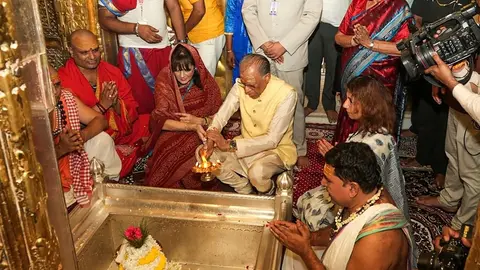Navinchandra Ramgoolam, the Prime Minister of Mauritius, offered prayers at the newly consecrated Shri Ram Janmabhoomi Mandir on Friday, a gesture that underscored both personal devotion and the cultural bonds linking his island nation to India.
Arriving with a high-level delegation, Mr. Ramgoolam was welcomed with Vedic chants, traditional music, and ceremonial rituals before entering the sanctum. He spent nearly half an hour inside, performing darshan of Lord Ram and interacting with priests and temple authorities.
Earlier in his trip, the Mauritian leader visited the sacred Kashi Vishwanath Temple in Varanasi and witnessed the Ganga Aarti, framing his state visit to India as not only diplomatic but profoundly spiritual.
Faith and Diplomacy Intertwined
Mauritius has long described its ties with India as “civilisational,” reflecting centuries of migration and the persistence of traditions rooted in the Ramayana. For a large part of the Mauritian population, Hindu practices and festivals remain central to cultural identity. Mr. Ramgoolam’s pilgrimage, Indian officials noted, symbolizes this living connection as much as it does interstate diplomacy.
A Message of Solidarity
Officials accompanying the Prime Minister said he prayed for the welfare of both nations and reaffirmed his commitment to deepening bilateral ties. His visit came amid a broader tour that includes discussions on infrastructure, healthcare, digital cooperation, and education, but the temple stop gave his journey an emotional resonance.
Symbolism Beyond Ceremony
For India, the visit was more than an act of religious observance. It was also a reminder of how spiritual and cultural affinity continue to serve as pillars of its diplomacy with the diaspora. “When we come to Ayodhya, it is not just India’s heritage, but our heritage too,” one Mauritian delegate remarked.
Mr. Ramgoolam’s presence in Ayodhya added international dimension to the newly inaugurated temple, positioning it not only as a domestic symbol but also as a site of global Hindu identity and cultural diplomacy.


